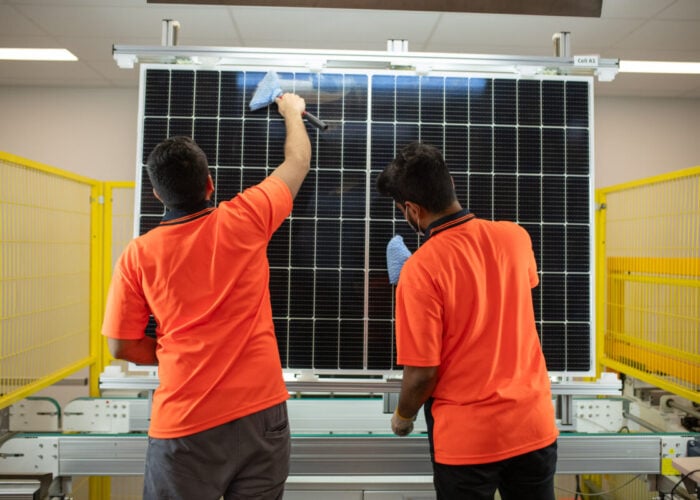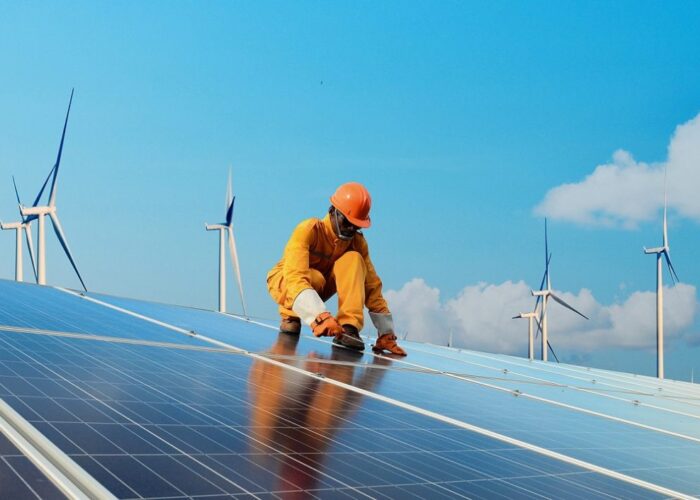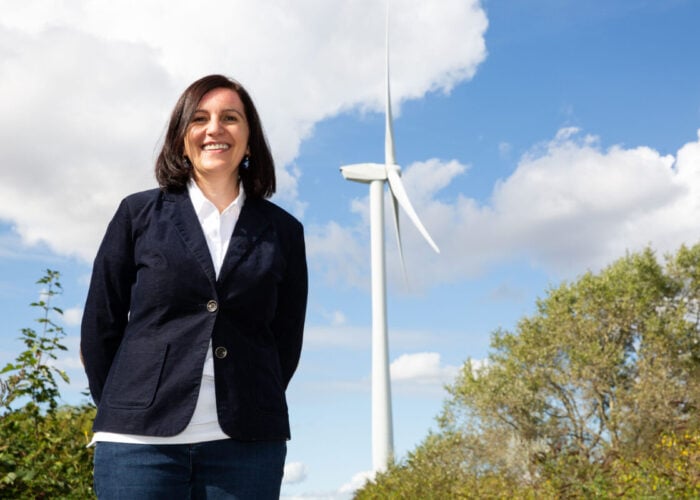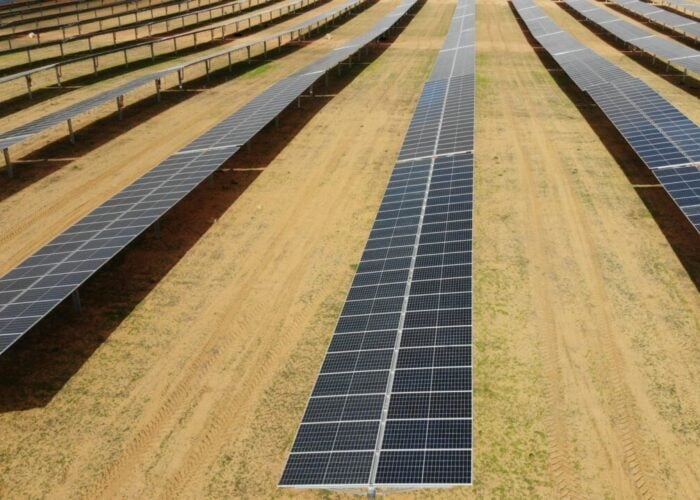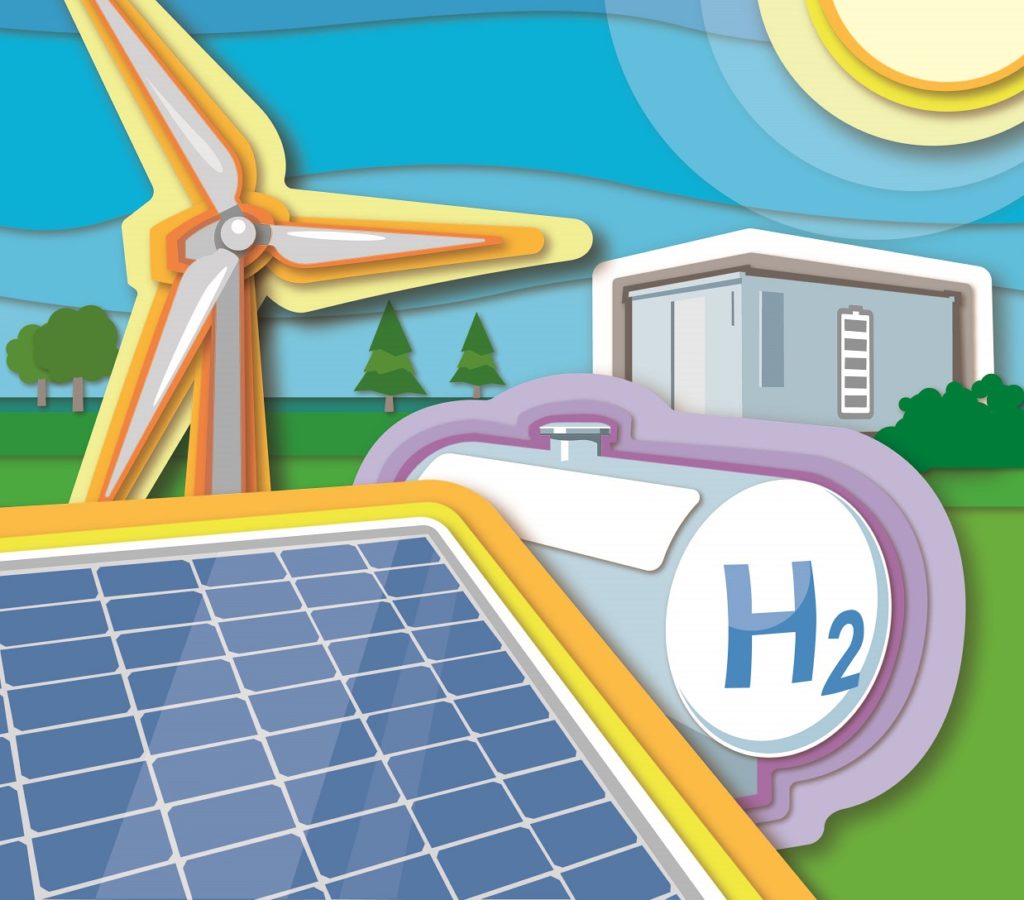
The proliferation of solar requires PV projects to adapt to their grid surroundings, which increasingly entails connecting alongside adjacent technologies, be it energy storage, other renewables or green hydrogen. Amid the growing threat of curtailment, Jules Scully looks at the rise of the ‘solar-plus’ market and the financial models underpinning it.
On a sunny Sunday afternoon this May, California reached a major milestone on its path towards a carbon-free free power grid, as the state produced enough renewable electricity to meet more than 100% of demand for the first time.
Unlock unlimited access for 12 whole months of distinctive global analysis
Photovoltaics International is now included.
- Regular insight and analysis of the industry’s biggest developments
- In-depth interviews with the industry’s leading figures
- Unlimited digital access to the PV Tech Power journal catalogue
- Unlimited digital access to the Photovoltaics International journal catalogue
- Access to more than 1,000 technical papers
- Discounts on Solar Media’s portfolio of events, in-person and virtual
Renewables generation exceeded demand for about 112 intermittent minutes and reached a new high of 103.45% for 1 – 2 minutes on 8 May, according to the California Independent System Operator (CAISO), which manages the flow of electricity for about 80% of the state.
The landmark followed a host of renewables records being broken in California throughout spring. Ashutosh Bhagwat, chair of the CAISO board of governors, said in April: “These moments help crystallise the vision of the modern, efficient and sustainable grid of the future.”
Although the milestone illustrates California’s progress in renewables deployment, it also raises questions about how the state will navigate solar curtailment and negative pricing as it bids to reach 100% zero-carbon electricity by 2045.
Some 5% of all utility-scale solar generation was curtailed by CAISO in 2020, research by the US Energy Information Administration (EIA) revealed. With curtailment more prevalent during spring when solar output is high and electricity demand drops due to moderate temperatures, the EIA found that CAISO curtailed an average of 15% of its utility-scale PV output in the early afternoon hours of March 2021.
To offset such trends, developers are increasingly hybridising solar projects with battery energy storage systems (BESS). A report from the US Department of Energy’s Lawrence Berkeley National Laboratory revealed that with California grappling with ‘duck curve’ issues due to solar’s relatively high market share, nearly 90% of the solar capacity in CAISO’s interconnection queue at the end of 2020 was paired with a battery.
One major installation set to come online in California, 70 miles north of Los Angeles, is the Eland Solar & Storage Center, which will pair 400MWac solar PV with 300MW / 1,200MWh of battery storage.
“Eland will deliver a consistent, baseload power supply at record-low prices: US$0.02/ kWh for solar only and less than US$0.04/ kWh with storage,” says Stephanie Perry, COO at project developer Avantus, recently rebranded from 8minute Solar Energy. “With a high capacity factor of 60% during the summer months (which is 50% more than a simple solar plant), the project maximises the use of existing transmission infrastructure.”
Eland has a long-term power purchase agreement (PPA) secured with municipal utility Los Angeles Department of Water and Power and is expected to be fully operational in 2024.
With a pipeline including 42GW of solar and 78GWh of energy storage, Avantus is looking to address grid issues like reliability and resiliency with its hybrid power projects, which can come online in a fraction of a second, compared to several minutes for gas-fired plants, according to Perry.
“Our smart power plants alleviate more than just curtailment issues, but can deliver flexible, predictable output to the grid and help utilities dynamically manage load,” she says. “Our novel controls enable storage and PV to work together as one seamless system, integrating renewable energy into existing electric grid control centres as if they were a traditional fossil fuel generator.”
With solar-plus-storage projects becoming commonplace globally, research organisation BloombergNEF (BNEF) forecasts that the majority, or 55%, of energy storage build by 2030 will be to provide energy shifting, such as storing solar to release later.
Despite the strong outlook for solar-plus-storage, developing such projects “is inherently more complex” than standalone storage because of the addition of an entirely different asset that needs to be integrated together to work as a system, according to Vanessa Witte and Sylvia Leyva Martinez, senior research analysts at research firm Wood Mackenzie.
“[Battery storage] allows us to have a far more stable network within the generation site… it also allows us to deliver the power at the most valuable times to the UK”
“This increases the complexity of the design of the system, the software and controls, and the offtake structures or other revenue opportunities the developer wants to pursue to make the project be economically viable,” they say.
Additional hurdles include a more expensive and more complicated interconnection process, with two requests needed, as well as timing procurement, construction, and commissioning so they all overlap advantageously. “With the current supply chain disruptions in solar, and the longer than before procurement times for storage, this has proved to be more challenging than ever,” add Witte and Leyva Martinez.
One company that is navigating these challenges is Primergy Solar, the developer behind the Gemini Solar + Storage project near Las Vegas, Nevada. Pairing 690MWac / 966MWdc of solar PV with 380MW / 1,416MWh of battery storage, Gemini is backed by 25-year PPA with utility NV Energy.
“A DC-coupled project of this scale and this size in single construction phase has not been done before,” says Aaroh Kharaya, director of storage engineering at Primary. “With DC coupled, you can connect/tie a lot of storage with solar in an efficient way.”
From a commercial standpoint, Kharaya says solar-plus-storage projects such as Gemini show that “renewable energy can become a dispatchable asset” like fossil fuel-based generation, while also helping to maintain grid stability.
Hybrid systems offer the solar industry a unique solution to dealing with grid connection challenges, said Fitch Solutions in a recent report, which namechecked Gemini as an example of a project that uses storage technology to enable older grid systems to facilitate renewable power.
The consultancy suggested that declining fossil fuel capacity in the US will leave legacy infrastructure, which is being repurposed, offering an easier deployment of renewables.
“We think that it’s likely that hybrid technologies will be more effective here because a lot of that infrastructure isn’t up to date and it isn’t equipped to handle large volumes of variable power supply,” says Thomas van Lanschot, associate director of power and renewables at Fitch Solutions. “This is long-distance, large-scale baseload power generation, so in order to use that more effectively, you have to couple in some kind of storage capacity.”
Primergy Solar, a portfolio company of private equity firm Quinbrook Infrastructure Partners, closed a US$1.9 billion debt and tax equity financing deal for Gemini earlier this year and has started construction of the project.
Van Lanschot says that in the US solar-plus-storage market, the financial models and structures are in place to get money to developers. “There’s quite a good diversity in finances as well. It’s not like there’s one particular bank to go after and they’re willing to take this risk. I think a lot of the risk has been dealt with.”
In addition to the potential of hybrid solar-storage solutions in the US, Fitch Solutions’ report found that hydrogen will act as a capacity growth enabler in the country, unlocking grid-constrained regions and reducing curtailed generation.
‘A natural hedge against volatility’: energy storage mitigating solar cannibalisation
With the threat of price cannibalisation rising in some markets as more renewables come online, battery storage has come to the fore as a possible mitigation tool to reduce an asset’s profile risk.
That is according to software and advisory company Pexapark, which warned in a recent report that cannibalisation will become more of an issue in markets such as Spain as high amounts of new solar connects to the grid, posing a “significant risk” for the long-term remuneration of projects.
However, the firm said that in theory a storage asset is a natural hedge against volatility, and a perfect match to increase an asset’s capture factors.
Werner Trabesinger, head of quantitative product at Pexapark, explains that energy storage enables assets to soak up production during times when the price is most cannibalised and then discharge those volumes later in the day when prices are higher. “What it does is it effectively floors the revenue level that you can get with solar production in the market,” he says.
While Pexapark’s report looked at three developed renewables markets in Europe where cannibalisation risk is already prevalent – Germany, Sweden and Spain – Trabesinger says countries such as Poland and Romania that are accelerating renewables buildout will over time be hit by lower price capture and higher cannibalisation.
Markets where there is a high anticipated solar capacity buildout, such as Spain, will lead offtakers to price very defensively, according to Trabesinger. “In other words, immediately get reflected in poorer levels of revenue on the PPA contract. And one way to escape that is to add battery storage to PV assets or, of course, for PV assets to be complemented by electrolyser assets.”
He says soaking up excess solar generation to produce hydrogen for later use “will become one of the central points speaking in favour of electrolyser efforts”.
Green hydrogen potential
One company that aims to use renewables generation that would otherwise be curtailed to power an electrolyser is Spanish utility Endesa, which has been awarded rights to develop a hybrid project in Portugal that will combine solar PV, wind, BESS and green hydrogen. The hybridisation of these technologies will make it possible to optimise production and obtain a high load factor, according to the company.
Set to replace Portugal’s last coal power station, which was shuttered last year, the installation will cost €600 million (US$660 million) and feature 365MWp of solar and a 500kW electrolyser, which will capture surpluses that exceed the BESS’ storage capabilities.
Pedro Almeida Fernandes, head of power generation at utility Endesa Portugal, said earlier this year that the company will be able to “fully capture all the renewable energy produced”, avoiding curtailment while improving the profitability of the renewables projects in the process.
Speaking at Solar Media’s Green Hydrogen Summit 2022, Almeida Fernandes said: “We can input this extra energy to the electrolyser at virtually the opportunity cost in order to be able to compete in H2 price.”
In a recent report, BNEF suggested that Europe could reduce the need for electrolyser-dedicated renewables by using excess green energy from grid-connected solar and wind to power electrolysers. The research organisation said that if electrolysers use 70% of curtailed solar and wind from the power system by 2050, Europe can reduce the hydrogen-dedicated wind and solar build by 20%.
There are existing electrolyser technologies that can ramp up and down quick enough to be paired with renewables, even in a curtailment sense, according to Wood Mackenzie’s Witte, Leyva Martinez and Bridget van Dorsten, a research analyst at the firm.
“The hydrogen produced then has multiple potential revenue streams and is therefore more versatile than battery storage,” they say, with it possible to sell hydrogen to off-takers in its gaseous form, or it could be transformed into liquid hydrogen, ammonia, methanol or liquid organic hydrogen carriers (LOHCs). Hydrogen could also be stored at the generation site and be run through a fuel cell to produce electricity during peak periods on the grid.
The potential to use solar-powered green hydrogen to ease grid congestion is being explored at a recently completed pilot project in the Netherlands from GroenLeven, a subsidiary of renewables developer BayWa r.e., and electricity and gas distribution network company Alliander.
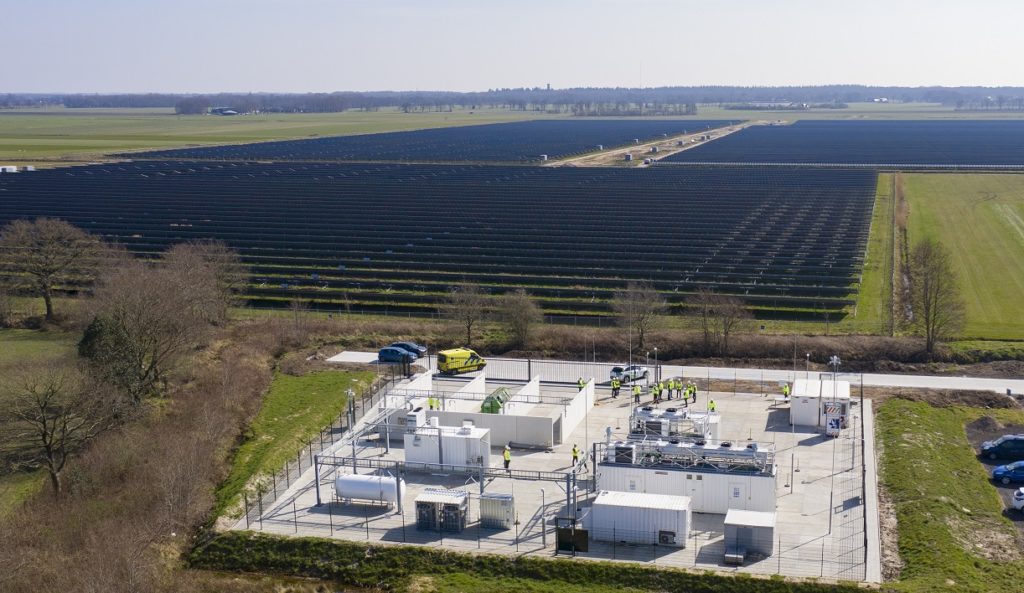
With the country’s grid becoming overstretched as more renewables come online, the project – pairing 50MWp of solar PV with a 1.3MW electrolyser – is being used to explore whether hydrogen is a solution to prevent costly grid expansions.
The companies are running different scenarios, sometimes optimising for the grid and sometimes for the electrolyser, explains Frank Oomen, head of large-scale solar projects at GroenLeven. “With the amount of solar PV behind it, you have the opportunity also to create significant load hours for the electrolysers so it’s not only for congestion.”
A spokesperson from Alliander tells PV Tech Power that the network company is looking to learn how it can quickly and easily convert electricity from the solar park into hydrogen and what regulatory obstacles it might encounter.
Among the challenges the partners faced when bringing the project to fruition was a lack of experience from regulators and permitting authorities when working on such installations as well as issues finding suitable contractors. “For everyone involved in this chain, there are challenges as first-timers on how to do it,” says Oomen.
It is expected that 100,000kg of hydrogen can be produced per year from the plant, with a taxi company and a fuel supplier signing up as offtakers.
Oomen believes it could still be a few years before a commercial solar-plus-green hydrogen plant becomes operational in the Netherlands. “It is relatively new to integrate all the things into such a solution, but all the components are there, so it’s not like we’re inventing something completely new,” he says. “The question is what the commercial feasible size will be.”
“As our country pushes toward a 100% clean energy grid, green hydrogen can critically extend the amount of renewable energy we store”
Another developer that is looking to benefit from a forecasted growth in hydrogen demand is Avantus. Securing US$400 million in financing earlier this year to grow its clean energy portfolio, the company revealed it plans to expand into green hydrogen.
As well as powering hard-to-abate sectors, green hydrogen is especially compatible with solar for its role in expanding the capabilities of energy storage, according to Avantus’s Perry. “As our country pushes toward a 100% clean energy grid, green hydrogen can critically extend the amount of renewable energy we store – potentially from a handful of hours to several months at a time,” she says.
Avantus is part of HyDeal Los Angeles, an initiative from non-profit organisation the Green Hydrogen Council that aims to deliver at-scale green hydrogen at US$1.50/kg in the Los Angeles Basin by 2030.
Perry adds: “We believe applying our integrated design approach and using our strategically positioned solar assets towards producing green hydrogen, we are poised to be an early cost leader in producing and scaling green hydrogen.”
Alongside hybridising with BESSs or even electrolysers to limit curtailment or capture additional revenue, solar developers are co-locating PV plants with other renewables assets to overcome grid constraints and make the most of points of interconnection.
Hybrid renewables plants
The benefits of hybridising floating PV (FPV) with hydropower were revealed in a report published in June by NREL, which found that the two technologies together can lower solar curtailment as well as conserve water by shifting hydropower generation to other periods of the year.
FPV and hydropower are set to be combined with a BESS at an installation in the south of Portugal from utility EDP. Having announced the completion in July of a 5MW floating solar farm at a hydropower dam in Alqueva, EDP now plans to add a 1MW/2MWh battery storage system. The company said the three technologies will share a single grid connection point, promoting “asset optimisation and efficiency while reducing environmental impacts”.
Following its success in Portugal’s solar auction earlier this year, EDP will also add an additional floating PV plant at the Alqueva dam. The grid connection it secured through the auction will allow the utility to install up to 154MW of renewables capacity, including the 70MW of contracts for difference-backed floating solar, 14MW of ground-mount PV and 70MW of wind.
Posting a negative bid in the auction, EDP said the hybridisation component and the scale of the project will ensure its economic viability.
“Hybridisation is nowadays considered the logical growth path in the electricity generation industry since it increases project efficiency, allows the sharing of electric infrastructures [and] promotes cost stability,” EDP said in a statement sent to PV Tech following the auction.
The company plans to invest nearly €400 million (US$405 million) to develop more than 1.3GW of hybrid projects in Portugal in Spain that will feature a combination of solar PV, wind, and hydropower.
Hybridising solar, wind and battery storage is a strategy set to be deployed by Xlinks, a company that bids to transmit electricity from a desert in Morocco to the UK via four 3,800km-long subsea cables.
Its Morocco – UK Power Project will feature 7GW of solar PV, 3.5GW of onshore wind and 5GW / 20GWh of battery storage that provide a near-constant source of flexible and predictable renewable energy, designed to complement renewable energy generated in the UK, according to the company.
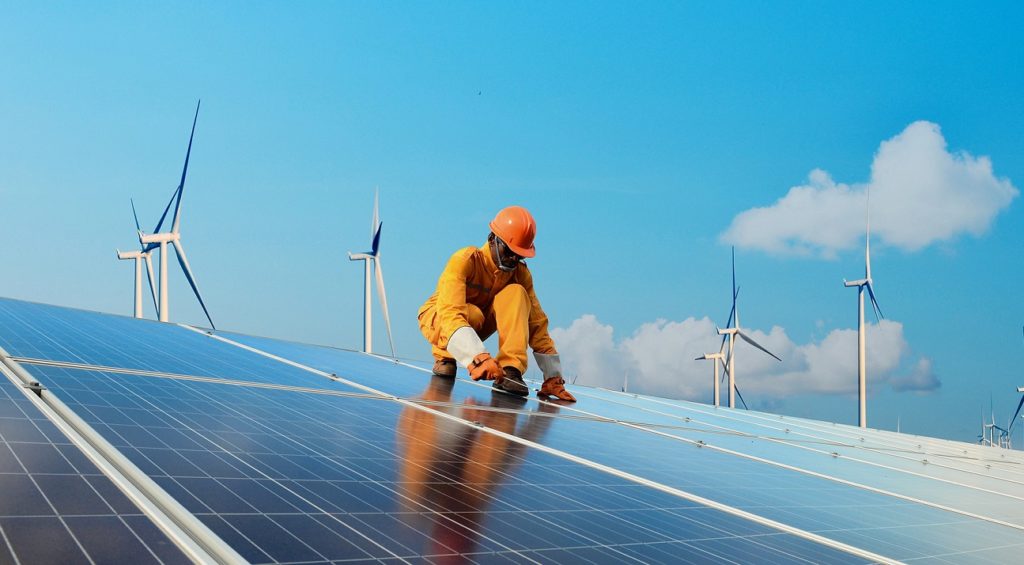
When UK renewables generation falls due to low winds and short periods of sun, the project will harvest the benefits of high solar irradiance in the south of Morocco alongside consistent desert winds to provide an alternative source of zero carbon electricity.
Xlinks will charge the BESS throughout the day, when there is excess generation, and then discharge it overnight, allowing the company to use the transmission system for more of the time and provide a more reliable generation profile to the UK, explains Richard Hardy, project director at Xlinks.
“Battery storage does play a very key role in that it allows us to have a far more stable network within the generation site, which is the first important point, it also allows us to deliver the power at the most valuable times to the UK,” he says.
The four high-voltage direct current (HVDC) cables will be rated at just over 4GW in Morocco and be installed along the coasts of Portugal, Spain and France before linking to Britain’s electricity network through two connections in Devon, southwest England, where 3.6GW will be injected into the network.
With groundbreaking scheduled for 2024 and power delivery to the UK by the end of the decade, the project is expected to deliver power at £48/MWh (US$57/MWh) when it becomes operational, meaning it will generate savings for consumers, said Xlinks.
While export projects such as this promise to accelerate the transition to net zero while generating savings for consumers, homeowners are increasingly looking to counter soaring energy bills and the threat of power outages by deploying their own solar-plus-storage systems.
Home batteries and EVs
BNEF expects energy storage located at homes and businesses to make up about a quarter of global storage installations by 2030, with major drivers being a desire from electricity consumers to use more self-generated solar and an appetite for backup power.
The research organisation said in a report that as energy storage costs fall, a second transition is beginning, where customer-sited solar combined with storage can begin to provide greater benefits to the power system in terms of energy balancing, grid services and increased resilience.
Germany, Italy, Austria and the UK are residential energy storage leaders in Europe, Wood Mackenzie said last year. The group forecast that the continent’s residential energy storage market will expand nearly tenfold this decade amid the need for power market flexibility.
Van Lanschot of Fitch Solutions says hundreds of thousands of domestic batteries are installed each year in Germany, which is “driving the residential solar boom” in many parts of the country. “This has created a whole new sector of community energy pools where people’s homes are communicating with each other, harmonising like a little mini-grid.”
Such growth in residential storage means utility-scale battery plants in Germany are “almost being outcompeted” and are less prevalent than in other markets such as the UK, US or Australia, van Lanschot says.
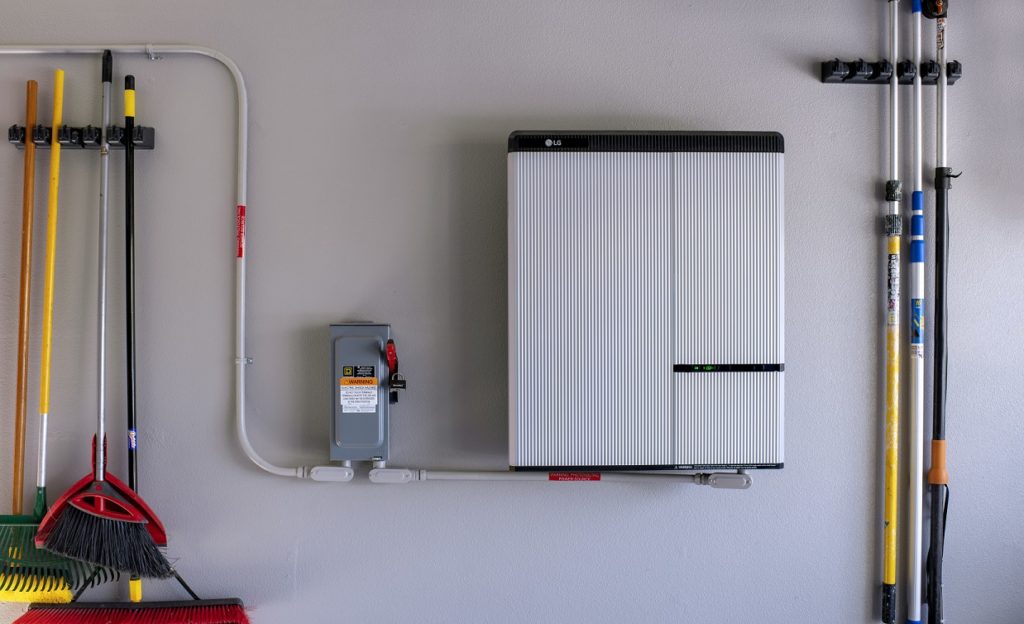
In the US, trade body the Solar Energy Industries Association forecasts that more than 29% of new behind-the-meter solar systems in the country will be paired with storage by 2025, compared to under 11% in 2021.
With regional transmission operators across the US issuing warnings to customers in anticipation of grid capacity shortages this summer, home solar and storage provider Sunrun said in July it is ready to support the country’s grid by dispatching the company’s installed battery capacity of more than 150MW. CEO Mary Powell said at the time that the firm’s solar and battery systems can provide a critical service by discharging electricity to the grid when it’s most needed.
Rival residential solar and storage provider SunPower is part of a consortium that has secured US Department of Energy funding to develop two home communities in California that will feature PV systems and be used to compare community-level versus residential-level energy storage batteries, while providing grid services to the local utility.
Both Sunrun and SunPower are among the growing list of residential solar providers that have collaborated with electric vehicle (EV) charging companies as they look to maximise the benefits of combining the technologies.
Rooftop solar and EV charger tie-ups abound
The increasing penetration of residential solar, large-scale installation of EV chargers and declining BESS costs are persuading companies to bring integrated solutions to the market by forming strategic alliances, according to Amaiya Khardenavis, EV charging infrastructure and grid edge analyst at Wood Mackenzie. Notable partnerships include:
- A collaboration between Sunrun and Ford has seen the solar and storage provider become the preferred installer of a system that allows the latter’s F-150 Lightning electric truck to dispatch power to the home during an outage event. Sunrun also has the chance to persuade Ford F-150 Lightning owners to install residential solar and storage at the same time as an EV charger.
- SunPower partnered with Spain-headquartered EV charging provider Wallbox last year, adding EV charging technologies to its portfolio. Through the tie-up, consumers can choose to have both rooftop solar and EV charging technologies installed at the same time, while SunPower has become Wallbox’s preferred solar and storage provider.
- Wallbox has since joined forces with Svea Solar, becoming the main EV charging solution for the European home solar installer’s customers in Sweden, the Netherlands, Belgium, Germany and Spain. A Wallbox app allows homeowners with rooftop solar to charge their EV solely from their home PV installation or combine onsite solar with grid power.
- Microinverter supplier Enphase Energy secured a deal last year to acquire ClipperCreek, a California-based EV charging station manufacturer that offers solutions for residential and commercial customers across the US. Enphase said the deal would provide its distributors and installers with EV charging solutions that can be sold alongside solar and battery systems.
- US residential solar and storage provider Sunnova offers its customers EV chargers through a partnership with charging solutions provider ChargePoint.
- According to Khardenavis, Tesla’s Powerwall offers a solution by providing stored solar energy to charge an EV through the home electrical panel.
Shawn Fitzgerald, vice president of corporate development at SunPower, explains that the company’s partnership with EV charging provider Wallbox allows SunPower to control the EV charger, subject to the customer signing up to its virtual power plant solution. “It just gives us more flexible loads to work with,” he says.
While utilities typically design rates so that the middle of the night is the most optimal time to charge an EV, Fitzgerald says consumers with an EV plugged in during the day can take advantage of low or negative power prices when there’s too much solar being exported to the grid.
Amaiya Khardenavis, EV charging infrastructure and grid edge analyst at Wood Mackenzie, says that as markets move towards a higher penetration of distributed energy resources in the electricity system, residential solar and storage offer an efficient and cost-effective way of EV charging when paired with level 2 chargers.
He adds: “Since most EV charging currently happens at home, such deployments would reduce the energy bills of EV owners, especially with the likelihood of sustained increase in electricity prices, driven by high natural gas prices.”
According to Wood Mackenzie, 17% of new residential solar systems in the US will be paired with storage in 2022, rising to 32% by 2026. At the current levels of EV adoption, the number is much lower for projects paired with EV charging.
However, the requirement for residential EV chargers will grow as EV uptake increases, Khardenavis says, leading to more homes installing chargers in conjunction with existing or new residential solar and storage systems.
With BNEF forecasting that at least 63% of the 1.4 billion passenger vehicle fleet globally will be electric by 2050, there will be significant potential for customer-sited flexibility and rooftop solar.
In terms of the outlook for pairing utility-scale PV with other technologies, the number of cross-border interconnection developments featuring renewables generation and BESS, such as Xlinks’ Morocco project, looks set to expand and take solar to new heights.
With plans to deploy 17 – 20GWp of solar and 36 – 42GWh of battery storage in Australia, developer Sun Cable is progressing with its landmark Australia-Asia Power-Link project that bids to transmit 2GW of electricity to Singapore.
Financial close for the project is set to be reached in 2024, when construction work will also begin. With full operations aimed for 2029, electricity will be transmitted to Singapore through 4,200km of HVDC subsea cables.
The development “will unlock solar energy’s latent potential to support many more projects to meet energy demand in the region”, says project director Andrew Barton. He adds: “Yes, the AAPowerLink is the first of its kind, but we believe it will be the first of many.”


